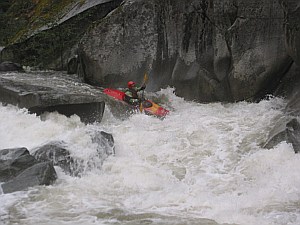
Written by Chris Shackleton
The Slab Creek flow study was held on Oct 31, Nov 1 and Nov 2, 2003, as part of the Sacramento Municipal Utility District's (SMUD'S) relicensing of the Upper South Fork American Hydropower Project. The purpose of the flow study was to identify the minimum acceptable and optimum flows for this reach, as well as answer additional questions such as the suitability of the run for river running, the level of boater interest, safety, logistics and more. This article, with some additional explanatory paragraphs, was published in American Whitewater, March/April 2004.
 |
| Wallflower |
This didn't feel at all like a normal paddling day - on the contrary, this felt like the mission it was. Once we settled down and got into our rhythm, though, I think we all really started to enjoy the run. The scenery is good to marvelous, depending on your tree and bush type preference. Some interesting rock formations. The river crosses underneath the bridge at Mosquito Ridge Road, otherwise most of the run feels well away from civilization, and probably is. There are many excellent rapids, especially in the first half. A really nice mix of Class IV and IV+, I thought. Even the Big One (named Mother Lode Falls) isn't quite as fierce as its reputation - though all of us wimpy paddlers were happy enough to walk it.
However the studs all ran it and mostly made it look reasonably easy. The flow on this day (scheduled to be 500 cfs but actually 610) was low but still quite reasonable in a hardshell. The R-2 didn't seem to have many problems, but full-sized rafts would surely hate it at that flow. Many of the rapids have a rock fence at the top that would hang up a raft at low flows - yet the body of the rapid tended to be bouncy enough to be quite exciting in a hardshell.
The second day (Nov 1) included almost all the same kayakers, but now without the R-2 crew (who joined eight other rafters to crew two 14' rafts). Flow was slated to be 1000 cfs but again it was a little higher - officially 1068 cfs. I think we kayakers were all surprised by how much pushier the river was at this flow. The rafts thought this was just about minimum acceptable flow, while we kayakers thought most paddlers would probably find 1100 cfs on the high side! I blame it on those darned rock fences at the top of so many rapids - a flow which is high enough to let rafts through easily is high enough to be quite pushy when a kayaker reaches the body of the rapid. Not that the rapids were hugely munchy at this flow, and in fact once you get to know the river it might seem relatively tame. But for at least some of us kayakers, not knowing what lay below, this was pretty darned intimidating.
 |
| Mother Lode Falls |
For my part I found myself really enjoying the big water feel in this section, though the holes pack quite a punch and to get caught in one could be memorable.
That was it for me - a fun day overall but near the limit of what I'm comfortable with. So I wimped out for the third and final flow study day, scheduled for 1500 cfs but predictably closer to 1600. I hear the day went well, with the rafters loving the higher flows and the kayakers only somewhat intimidated. By now the weak-kneed bunch had been weeded out, so pretty much only studs were left.
Hey, there's more to the South Fork American than Chili Bar. Overall I rate this run as excellent, a classic, definitely at the upper end of what's available in its class. This is a hidden gem that currently flows only when we're lucky - as a result of spill. This means boatable flows are very hard to predict, sporadic, erratic, and short-lived. Participation in the relicensing proceeding is critical to restore an annual schedule of flows for the next 30 to 50 years. American Whitewater, through the direct involvement of local boaters, is helping to make this possible.
Some interesting discussions and decisions are ahead of us, though, when we contemplate what to ask for in the way of scheduled releases. The kayaker optimum flow seems to be in the 850 or 900 cfs range, while it sounds like rafters are looking at 1500 or 1600 cfs. Not only that, but the rafter lower limit was pretty much the kayaker upper limit! Creativity is required if scheduled releases are to offer something for everyone.